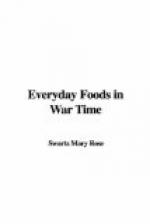If we substitute whole wheat for white bread, we can make a complete diet with two foods—this and milk. We get from the bran and the germ what in the other case we got from the spinach. All the cereals can be effectively supplemented by milk and green vegetables. If green vegetables (or substitutes for them like dried peas and beans or fruit) are hard to get we should give preference to cereals from which the bran coats have not been removed, such as oatmeal and whole wheat. Then the diet will not be deficient in iron, which is not supplied in large enough amounts from white bread and milk. Oatmeal is the richest in iron of all the cereals.
With such knowledge, we may alter our diet very greatly without danger of undernutrition. But we must learn to cook other cereals at least as well as we do wheat. Without proper cooking they are unpalatable and unwholesome, and they are not so easy to cook as wheat. They take a longer time and we cannot get the same culinary effects, since with the exception of rye they will not make a light loaf. Fortunately we are not asked to deny ourselves wheat entirely, only to substitute other cereals for part of it. Let each housewife resolve when next she buys flour to buy at the same time one-fourth as much of some other grain, finely ground, rye, corn, barley, according to preference, and mix the two thoroughly at once. Then she will be sure not to forget to carry out her good intentions. Bread made of such a mixture will be light and tender, and anything that cannot be made with it had better be dispensed with in these times.
Besides the saving of wheat for our country’s sake, we shall do well to economize in it for our own. Compared with other cereals, wheat is expensive. We can get more food, in every sense of the word, from half a pound of oatmeal than we can from a twelve-ounce loaf of white bread, and the oatmeal will not cost one-half as much as the bread. A loaf of Boston brown bread made with one cupful each of cornmeal, oatmeal (finely ground), rye flour, molasses, and skim milk will have two and one-half times the food value of a twelve-ounce loaf of white bread and will cost little more. One-half pound of cornmeal, supplemented by a half pint of milk, will furnish more of everything needed by the body than such a twelve-ounce loaf, usually at less cost.
It pays at all times to use cereals in other forms than bread, for both health and economy. Does your family eat cereal for breakfast? A dish of oatmeal made from one-fourth cupful of the dry cereal will take the place of two slices of white bread, each about half an inch thick and three inches square, and give us iron besides. Served with milk, it will make a well-balanced meal. When we add a little fruit to give zest and some crisp corn bread to contrast with the soft mush, we have a meal in which we may take a just pride, provided the oatmeal is properly cooked.




